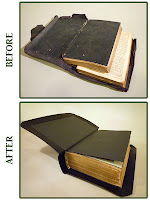
I'm finally finishing up the last two books from Chet Ross Rare Books, and they'll be complete tonight. The main reason why I've gotten behind on finishing these books is because of my masterrr! He gave me a couple of Bibles that needed to be done in a couple of days... Anyway, this is one of the Bibles. I forgot to check the publisher and the date of this Bible, but I took some pictures of the process of a partial re-sewing. I'd assume that the complete re-sewing is a no brainier to most people, but I thought some people might wonder how bookbinders re-sew a partially broken signatures without completely breaking down the book. This is one of the methods of re-sewing the parts of broken signatures. Basically, what's shown here is to connect the original thread to a new one, and sew the broken signatures together. Anyway, the owner of this Bible wanted a facsimile case, but didn't want to spend money on leather. So the cover material is a black imitation leather buckram with a flap on the edges. (Yapp binding)



Do we know anything about William Yapp, the 19th century bookseller who some say invented the Yapp binding?
ReplyDeleteHe may well have been a relative. My great grandfather moved from Herefordshire to London some time late in the 19th century. Check out the Brethren Archive online. William Yapp was a highly respective member of the Brethren. He was born on 14th April 1807, and received his 'Home call' on 28th November 1874.
ReplyDeleteWell, only thing I can tell you about "Yapp binding" is the earliest Yapp bible I've restored was published in the mid 1800's. Unfortunately, I'm not familiar with a binder who's surname is Yapp. I apologize for my ignorance on this matter.
Delete